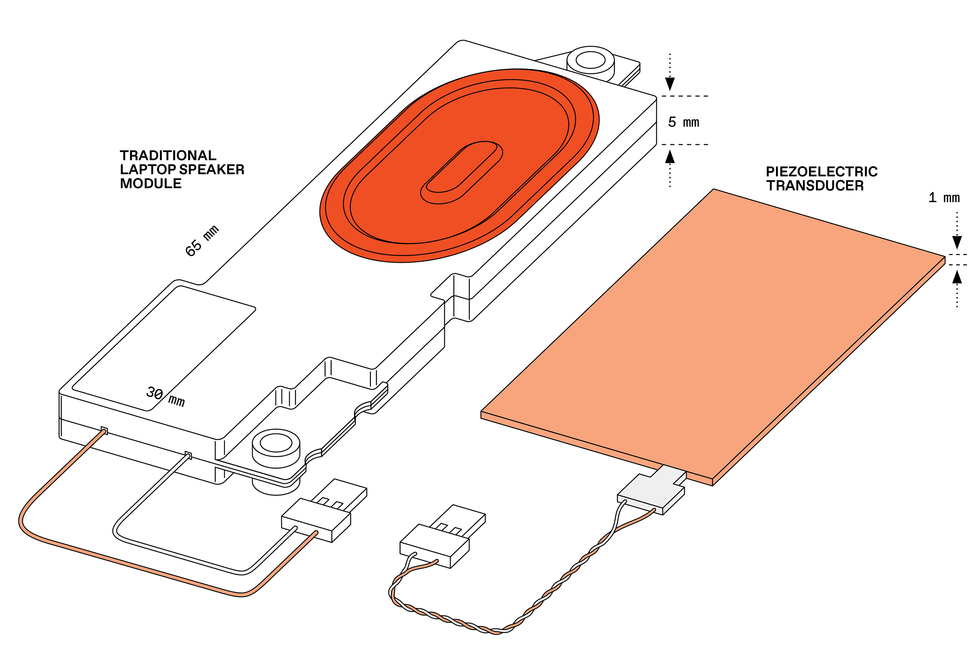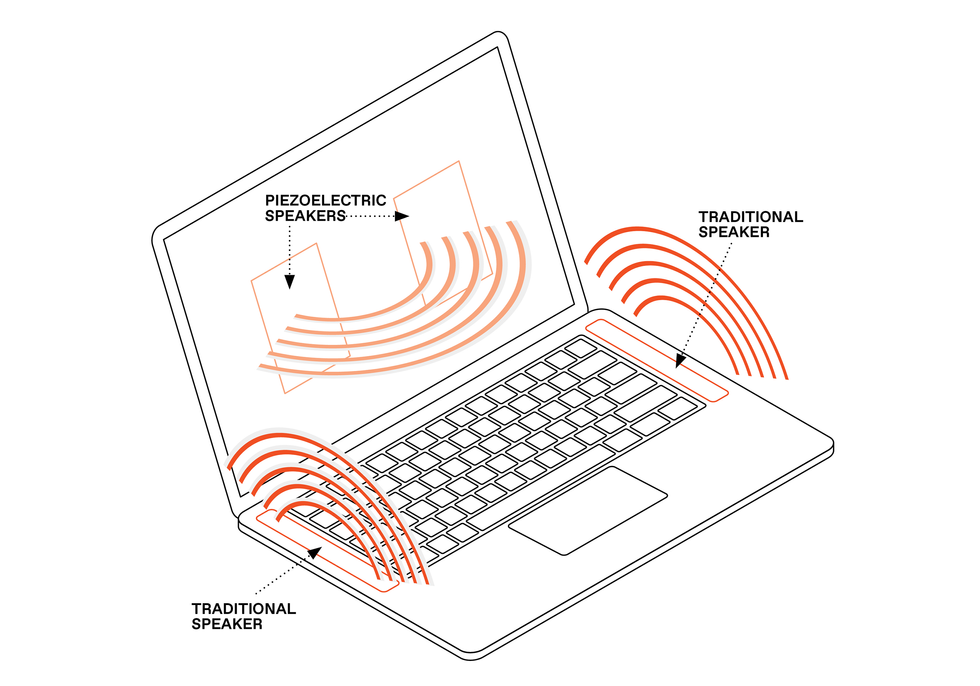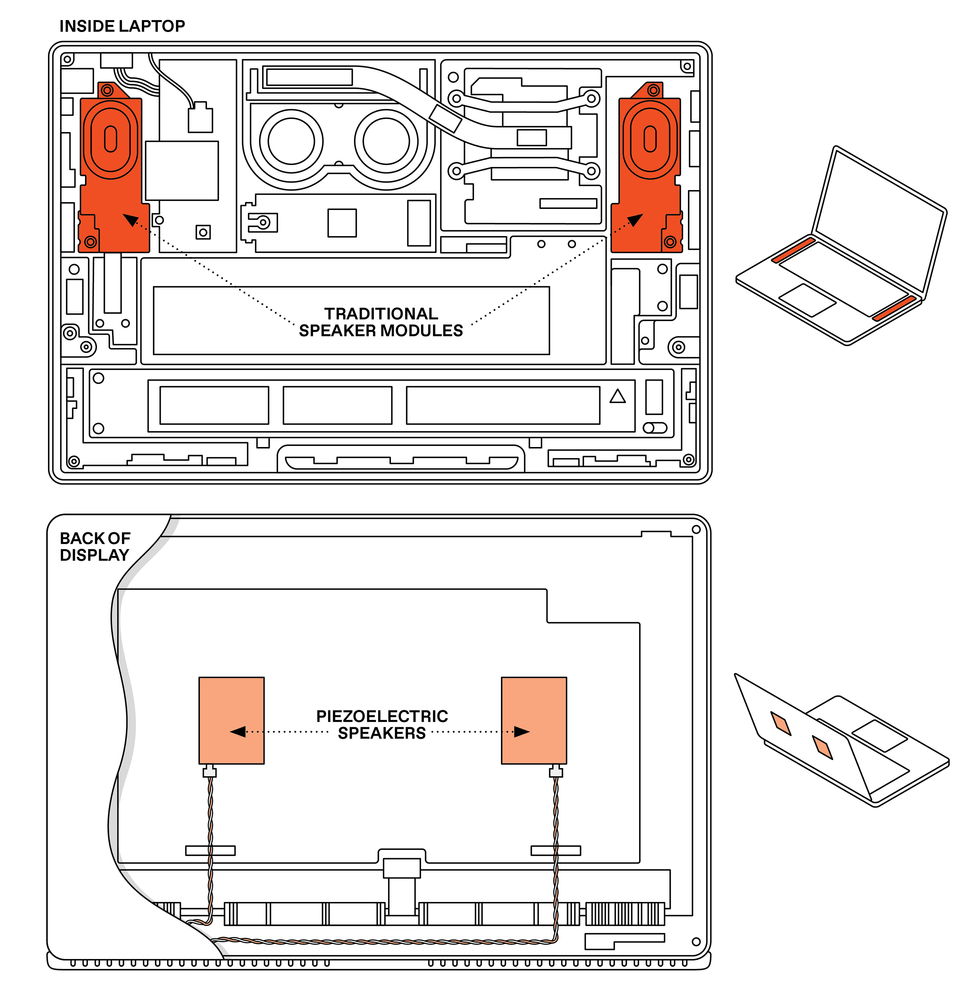Smartphone Screens Are About to Become Speakers
Piezoelectrics enable displays to provide both high-quality audio and touch feedback

Today’s mobile-device speakers and haptic generators have several problems.
The first is with the components themselves. The speakers in your smartphone and the system that gives your finger feedback when you touch a virtual button may be relatively small, but they are still big enough to limit how thin our mobile devices can get. These little components are also delicate, as you may have learned if you have dropped your phone. And they require openings in the enclosure that can admit moisture or debris.
Then there is a problem with the way we perceive the sound they emit. Speakers usually sit on the sides or back of our devices. The sound is supposed to be coming from the image that our eyes see on the screen, but our ears know it’s coming from somewhere else. This perceptual dissonance limits our ability to immerse ourselves in the experience.
We could solve all these problems at once if we could use the display panel itself as the source of sound and haptic feedback. The technology to do this is now available—it’s a thin piezoelectric transducer. And it’s going to be moving into mobile phones, laptops, and wearables by the end of this year.
Speakers today
Traditional speakers function by running a current through a coil, creating a magnetic field that moves a magnet attached to the speaker cone, which in turn displaces air to create a sound wave. The speaker can be no smaller than is allowed by the size of the coil and the cone, which must be wide enough and long enough to displace a reasonable volume of air. Its mechanical durability is limited by the precision with which its small moving parts must be assembled.
Haptic generators in handsets typically are linear resonant actuators, which are electrically and mechanically like speakers but are optimized to create low-frequency vibrations in a solid rather than sound waves in the air.

It turns out that both sound and haptic generation can be wrung from the display of a mobile device. The display is a uniform, flat, semiflexible surface–If you tap on it with a fingernail, you can hear it vibrate. The technology to turn flat, semiflexible surfaces into loudspeakers dates to the early years of high fidelity.
In the 1950s, you could buy just the part of the speaker that converted electricity into motion—the coil and piston—and attach the piston to a wall or the panel of a cabinet. The wall or panel then vibrated—like a speaker cone—creating the air-pressure waves we perceive as sound. That idea remained a novelty, mainly because it was a do-it-yourself project with unpredictable results. Finding the right surface, mounting the driver in the right place, and powering it properly turned out to be about as easy as building a really good violin.
More recently, some flat-screen TV developers have turned the screens of large-format TVs into speakers using a similar principle. They use powerful transducers to vibrate the whole display panel at audio frequencies. This delivers the goods: thin displays, no speakers. According to reviewers, the fidelity is great at midrange and high frequencies (if you want low frequencies, you’ll want a supplementary subwoofer). And the sound really does seem to be coming from the images on the screen. But these systems are expensive and require high-voltage amplifiers that consume considerable power, so they need to be shrunk before they can fit into a mobile device.
Enter Piezoelectrics
To do the job in smaller devices you need piezoelectric transducers. These are made up of tiny single crystals, such as quartz or some ceramics, with two electrodes attached. When you apply a voltage across the electrodes, the material physically bends.
That bending is called the converse piezoelectric effect. In 1880, physicists Pierre and Jacques Curie observed that when certain crystals were subjected to mechanical force, a voltage would appear between the faces of the crystal; they called this the piezoelectric effect ( piezo is Greek for “to press”). This effect is due to the interaction between natural electric dipoles in the crystals and mechanical stresses in the crystals’ molecules. Roughly speaking, bending the crystal causes the dipoles to align, creating a bulk electric field.
A year later the Curies demonstrated that the converse was true: If a voltage was applied between the faces of these crystals, the dipoles would bend the crystal as they try to align with the field. Work on piezoelectric materials subsequently expanded to include ceramics.

So by applying an alternating voltage, you can make the transducer vibrate with rather considerable force. These vibrations can be slow—the kind needed for haptic feedback—or very fast, to the highest audio frequencies and beyond. While creating the effect with ceramic material requires relatively high voltages—in the range of 40 volts or more—it requires very little current and, hence, little power—far less than the power used by mobile device speakers today.
Using piezoelectric transducers to generate sound isn’t a new idea. In fact, they’ve been used for decades to produce the unbearable shriek of a smoke alarm.
Of course, using piezoelectrics to produce a full range of high-quality audio is a long way from making a smoke alarm screech. There are a number of challenges to making it work in a handheld device. There is the need for an amplifier able to step up the voltage that batteries can provide, with high efficiency to conserve energy, and with minimum noise, to preserve audio quality. And the audio signal needs some preprocessing before you send it to the transducer, to correct for the characteristics of the transducer and the display panel that the transducer will shake.
Driving the Transducers
But we at Synaptics think that we’ve met those challenges. We’ve developed a chip that incorporates a low-noise, high-voltage boost amplifier and a digital signal processor that sits on a device’s main board and drives a ceramic piezoelectric transducer attached to the back of the display. This does take up space, but then again, it eliminates the moving coil speaker. The exact placement and number of these amplifier-transducer sets depends on the mechanical design of the device and the desired audio modes—one set is enough to replace the handheld receiver functionality in a smartphone, but a second set will be needed to also replace the speakerphone function. That configuration will be the more typical one.
We expect to see our chip in smartphones, wearables, and laptop computers by the end of 2024.

The immediate benefits of moving away from traditional magnetic coil speakers are many. The piezoelectric transducer material requires only one millimeter of enclosure thickness, compared to several millimeters for dynamic speakers or linear resonant actuators, enabling a new generation of thinner handheld devices. Yet such transducers can produce the sound quality and the loudness of the best miniature dynamic speakers. They are being made by a few companies, including TDK; others have yet to be announced publicly.
Since the transducers are bonded to the display panel inside the enclosure, they require no openings that could allow moisture or dirt inside.
Most importantly, the transducers produce sound waves from the front of the display. This means the sound is directed at the user, not away from the user or off to the side. As the success of sound-generating displays in large-screen TVs has demonstrated, this does in fact provide a more immersive experience. When you see the T-Rex throw back its head and roar, your brain locates the source of the sound at the image of the beast, not somewhere off to the side.
Many of today’s handheld devices do attempt to correct for this problem by what is called psychoacoustic processing, using an algorithm to change the amplitude and phase of the sound waves coming from the speakers, mimicking some of the very complex things that your ears do as sound waves enter them from different directions. The success of these algorithms depends on the surroundings, and extra processor cycles take noticeable energy from the device’s battery. Having the sound physically originate on the display is a far simpler solution.
As for haptic feedback, using the same piezoelectric transducers that generate sound to generate haptic feedback eliminates the need for separate driver electronics and a motor to shake the display.
A Two-Way Street
Also, recall that the piezoelectric effect works both ways. So when you touch the display panel, not only can a conventional touch sensor determine where you are touching, but the piezoelectric transducer can tell how hard you are pressing. This opens a whole new realm of feedback for interactive user interfaces and immersive touchscreen games.
It also raises an interesting possibility that, frankly, has not been thoroughly explored yet. When a touch, or even reasonably loud ambient noise, flexes the display panel, it will also flex the transducer, generating a voltage. This electrical signal could be harvested to charge the device’s battery, providing a level of energy harvesting that might prolong the time between charges.
So if your next phone is thinner, has a longer battery life, and more immersive sound, thank piezoelectrics for eliminating the traditional speakers and motor-based haptic generators from your device, and moving the sound up front, where it belongs.
This article appears in the March 2024 print issue as “TheScreenIstheSpeaker.”
- Speaker Chip Uses Ultrasound to Crack Volume Limits ›
- Acoustic Fiber Can Turn Fabrics Into Mics and Speakers ›


